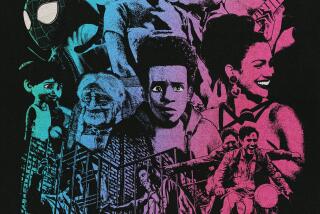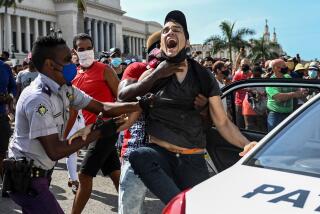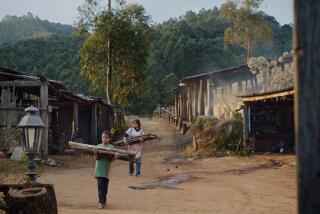âHemingwayâ filmmaker Bob Yari sees Cuba as a cinematic Garden of Eden after U.S. bid farewell to embargo
Just months before President Obama told Congress to lift its 55-year embargo on Cuba in 2014, Bob Yari was on set in Havana, directing an action sequence of young revolutionaries attacking the presidential palace.
In the midst of shooting the scene for his film âPapa: Hemingway in Cuba,â which opened in theaters Friday, Yari was approached by an extra in the crowd.
Our complete summer movie guide >
âShe pointed up to a balcony and said, âWhen I was 16 years old, I watched what youâre shooting from right there,ââ Yari said. âThey still have the bullet holes in the building.â
Authenticity down to the bullet holes was Yariâs goal when he took on the formidable task of making âPapa: Hemingway in Cubaâ â the first Hollywood film to shoot in the Communist country since 1959.
Yariâs film is likely to be the first in a wave â with the recent opening of Cubaâs borders, more American productions are setting up in the Caribbean time capsule, including Universalâs âFast and the Furious 8,â which began shooting in Havana last week, and Showtimeâs âHouse of Lies,â which shot an episode there earlier this year.
For Yari, the decision to film in Cuba stemmed from his source material, the true story of a young journalist who befriended Hemingway as the Cuban revolution escalated around them in the late 1950s. âPapa: Hemingway in Cubaâ stars Adrian Sparks as the white-bearded author who lived in Cuba from 1939 to 1960, and Giovanni Ribisi as a Miami newspaper reporter inspired by Denne Bart Petitclerc, who wrote the script before he died in 2006.
âI remember reading the script and feeling Cuba was another character in the movie,â Yari said. âIt was so much about Hemingwayâs love affair with the country.â
Yari secured permission to film before the embargo was lifted through a State Department loophole that allows for fact-based projects. The Cuban government, he said, fully cooperated and didnât attempt to censor any scenes.
âPart of me believes that opening the doors to U.S. filmmakers was a motivation for them,â Yari said. âBut the biggest one was the fact that Hemingway was a national hero to them. Heâs a wonderful bridge between the two countries. They loved the idea of a Hemingway film set around his time in Cuba.â
Even with that official approval, however, the less than $3-million production faced major hurdles: U.S. and Latin American banks froze their accounts on multiple occasions, Yari said, fearing recriminations from the U.S. Treasury Department enforcing the embargo.
There is a crew base and a well-regarded film school in Cuba, but Yari, who is best known as a producer of films such as âCrashâ and âThe Illusionist,â had to reconcile the disparate working styles of American and Cuban film crews.
âEverything has a more relaxed, easygoing attitude there,â Yari said. âWith communism, the reward system isnât there. If you bust your rear end or are a couch potato, you get the same thing. That clashes heavily when youâre on a tight schedule with a U.S. crew thatâs used to doing things more efficiently.â
Except for one brief flashback scene, Yari shot the entire movie in Cuba, including portions of the story set in Miami. His mainly Cuban cast and crew took advantage of locations there largely untouched in the intervening decades, including Hemingwayâs home, which is now a museum, the Havana waterfront and the University of Cuba.
âIn that world of literature, Hemingway is a mythical figure,â Ribisi said. âAnd here we were with his typewriter, his photographs, his artwork, his furniture.â
There were no air conditioned trailers for the cast or well-equipped catering trucks, but there were distinct advantages for someone shooting a period film â the majority of the cars on the road are from the 1950s, and Havana is still mostly free of advertising and other signs of modernity.
âCuba is really a time machine and a monument,â Ribisi said. âItâs this forbidden place, just an hour away from Miami.â
Despite the chilly relationship between Cuba and the U.S. over the last 55 years, Cuban spectators watching the filming were mostly friendly, Yari said.
âWhen Adrian Sparks was in wardrobe, people would be yelling âPapa!â down the street,â he said. âThereâs mistrust, because everything in Cuba is blamed on the embargo, but thereâs a side of Cubans who really like Americans.â
Before the Cuban revolution, Warner Bros. filmed parts of the 1958 Spencer Tracy adaptation of âThe Old Man and Seaâ in Havana. More recently, the country has mostly appeared on American movie screens in documentaries like Michael Mooreâs âSickoâ (2007) and Wim Wendersâ âBuena Vista Social Clubâ (1999).
Cuban audiences had the chance to be among the first to see Yariâs film in December at the Havana Film Festival, where it screened at a 1,600-seat theater.
Since then, Yari said, he has fielded calls from other filmmakers, including Ethan Hawke, who are interested setting up shop there.
âIâm so glad this terrible embargo is going away,â Yari said. âHopefully it will mean more prosperity and openness for the Cuban people.â
ALSO:
Explore Papa Hemingwayâs comfortable, easygoing homestead in Cuba
Perspective: New films are dropping more Americans abroad. Is it a good thing?
Not all American films travel easily. It takes expertise to connect them with foreign audiences
More to Read
Only good movies
Get the Indie Focus newsletter, Mark Olsen's weekly guide to the world of cinema.
You may occasionally receive promotional content from the Los Angeles Times.











